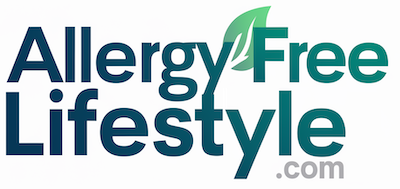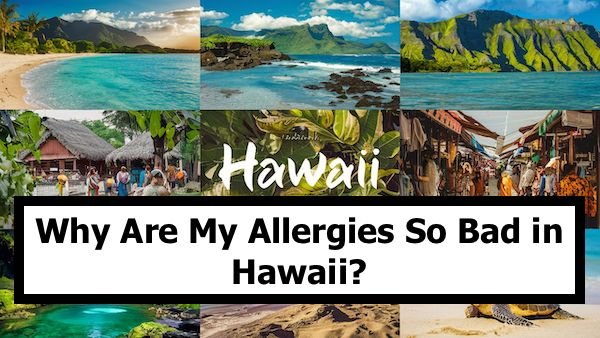Seasonal allergies, or allergic rhinitis or hay fever as they are also know, affect millions of people worldwide. These allergies occur when a person’s immune system overreacts to certain harmless substances such as pollen, mold spores, or pet dander. While allergies can strike at any time of year, spring and fall are notorious for their high pollen counts, leading to sneezing, itchy eyes, congestion, and overall discomfort. Depending on where you live, you might be living in the Worst Cities For Allergies in the US & Around The World.
The Impact on Daily Life
Allergy sufferers know the struggle all too well. Imagine waking up to a sunny morning only to find that your nose is congested, your eyes are watery, and you’re constantly reaching for tissues. Going outdoors becomes a battle against invisible enemies—pollen particles floating in the air. Simple pleasures like picnics, gardening, or enjoying a walk in the park become fraught with discomfort.
The Quest for Relief
People with allergies often seek refuge indoors, hoping that air conditioning and closed windows will shield them from pollen. They use antihistamines, nasal sprays, and other medications to manage symptoms. But what if you live in a city where pollen levels are consistently high? That’s where our exploration begins—the cities where seasonal allergies reign supreme.
What Are Seasonal Allergies?
As mentioned earlier, seasonal allergies occur when the body’s immune system reacts to (fights) allergens in the environment. These allergens are typically airborne and include pollen from trees, grasses, and weeds. When an allergic person inhales or comes into contact with these particles, their immune system releases histamines, leading to a cascade of symptoms.
Common Symptoms
Allergic rhinitis manifests with a range of uncomfortable symptoms:
- Sneezing: Frequent and sudden sneezing fits.
- Runny or Stuffy Nose: The nasal passages become inflamed, leading to congestion or excessive mucus production.
- Itchy, Watery Eyes: The eyes become red, itchy, and light-sensitive.
- Scratchy Throat and Coughing: Postnasal drip can cause throat irritation and coughing.
- Fatigue: Allergies can leave sufferers feeling drained and lethargic.
Pollen as the Culprit
Pollen is the primary trigger for many seasonal allergies. Different types of plants, including certain trees, release pollen at different times of the year:
- Tree Pollen: Springtime is notorious for tree pollen. Birch, oak, cedar, and pine trees release fine pollen particles that can travel long distances.
- Grass Pollen: Late spring and early summer bring grass pollen. Bermuda grass, ryegrass, and Timothy grass are common culprits.
- Weed Pollen: Ragweed, sagebrush, and lamb’s quarters release pollen in late summer and fall.
Allergic Asthma
Exposure to pollen can exacerbate allergic asthma in some individuals. Pollen particles irritate the airways, leading to wheezing, shortness of breath, and chest tightness. Managing both allergic rhinitis and allergic asthma requires vigilance and proper medical care.
Impact on Quality of Life
Seasonal allergies can significantly affect daily life. Imagine trying to concentrate at work or enjoy outdoor activities while battling constant sneezing and itchy eyes. Allergy sufferers often seek refuge indoors during peak pollen seasons, but even indoor spaces may not provide complete relief.
Factors Influencing Allergy Severity in The Worst Cities For Allergies in the US & Around The World
Tree, Grass, and Weed Pollen Scores
Cities with high pollen counts often have specific seasons dominated by different types of pollen. Understanding the local pollen calendar is crucial for allergy sufferers. Here’s how different types of pollen impact allergy severity:
- Tree Pollen: In spring, trees like birch, oak, and cedar release fine pollen particles. These can trigger allergic reaction-related symptoms in susceptible individuals. Cities with abundant tree cover may experience higher tree pollen scores.
- Grass Pollen: Late spring and early summer bring grass pollen. Bermuda grass, ryegrass, and Timothy grass are common culprits. Urban areas with extensive lawns, parks, and green spaces tend to have elevated grass pollen levels.
- Weed Pollen: Ragweed, sagebrush, and lamb’s quarters release pollen in late summer and fall. Cities with wild vegetation or neglected green areas may see higher weed pollen scores.
Over-the-Counter Allergy Medicine Use
The prevalence of over-the-counter (OTC) allergy medication usage can serve as an indicator of allergy severity. Cities, where residents rely heavily on antihistamines, nasal sprays, and eye drops, suggest a significant allergy burden. Access to effective OTC medications can make a difference in managing symptoms.
Availability of Board-Certified Allergists/Immunologists
Access to specialized medical care plays a crucial role. Cities with a shortage of board-certified allergists and immunologists may struggle to provide comprehensive allergy management. Timely consultations, personalized treatment plans, and allergy testing are essential for effective symptom control.
Urban Environmental Factors
- Air Pollution: Poor air quality exacerbates allergies. Cities with high pollution levels may worsen symptoms due to the interaction between pollutants and pollen.
- Climate: Climate influences pollen production. Warmer temperatures (summer, spring) and longer growing seasons can lead to prolonged exposure to allergens which is why some people’s allergies are so bad in Hawaii
- Botanical Sexism: Some cities favor male trees (which produce more pollen) for aesthetic reasons. This “botanical sexism” contributes to higher pollen levels.
The 2024 Allergy Capitals – Worst Cities For Allergies in the US
Wichita, Kansas
- Tree and Grass Pollen: Wichita consistently ranks high due to its abundant tree and grass pollen. Residents face a double whammy during spring and early summer.
- Allergist Availability: Access to board-certified allergists may be limited, exacerbating the challenges for allergy sufferers.
Virginia Beach, Virginia
- Coastal Allergies: Virginia Beach’s coastal location contributes to its high pollen levels. Sea breezes carry pollen from nearby vegetation.
- Symptom Severity: Residents experience intense symptoms, including itchy eyes, sneezing, and congestion.
Greenville, South Carolina
- Pollen-Heavy Environment: Greenville’s lush greenery and diverse flora mean constant exposure to pollen.
- Grass Pollen Dominance: Bermuda grass and other grasses thrive here, affecting allergy sufferers.
Dallas, Texas
- Urban Allergies: Dallas’s urban landscape doesn’t spare residents from pollen. Tree and grass pollen are major culprits.
- Air Pollution Interaction: High pollution levels worsen allergy symptoms.
Oklahoma City, Oklahoma
- Pollen Challenges: Oklahoma City experiences prolonged pollen seasons. Ragweed and grass pollen are prevalent.
- Allergist Shortage: Few board-certified allergists serve the population.
Tulsa, Oklahoma
- Weed Pollen Trouble: Ragweed dominates Tulsa’s fall season. Allergy sufferers brace themselves for intense symptoms.
- Botanical Sexism: Male trees contribute to higher pollen counts.
Richmond, Virginia
- Frequent Pollen Exposure: Richmond’s parks and green spaces ensure constant pollen contact.
- Allergist Gap: The city struggles to meet the demand for specialized allergy care.
Des Moines, Iowa
- Surprising Contender: Des Moines surprises with its pollen levels. Residents battle tree and grass pollen.
- Climate Influence: Warmer temperatures extend the allergy season.
Raleigh, North Carolina
- Persistent Pollen Troubles: Raleigh’s oak and pine trees release pollen throughout the year.
- Allergist Accessibility: Seeking professional help can be challenging.
Fayetteville, Arkansas
- Wrapping Up the Top 10: Fayetteville’s weed pollen, especially ragweed, keeps allergy sufferers on their toes.
- Local Efforts: The city aims to improve allergy management resources.
Climate Change and Botanical Sexism
Climate Change and Pollen Levels
- Warming Trends: Climate change directly impacts pollen production. As temperatures rise, plants release more pollen. Longer growing seasons extend the duration of pollen exposure for allergy sufferers.
- Increased Carbon Dioxide (CO₂): Elevated CO₂ levels enhance plant growth, leading to higher pollen production. This phenomenon exacerbates allergies.
- Altered Pollen Seasons: Climate shifts alter the timing of pollen release. Some cities now experience prolonged or shifted pollen seasons.
Botanical Sexism: The Male Tree Bias
- Male Trees Produce More Pollen: Many urban areas favor male trees for landscaping due to their tidy appearance (fewer fruits and seeds). However, male trees produce copious amounts of pollen.
- Pollen Overload: Streets lined with male trees contribute to higher pollen counts. This phenomenon is known as “botanical sexism.”
- Female Trees as Allies: Female trees, which produce less pollen, are often overlooked. Promoting a balance of male and female trees can mitigate pollen-related allergies.
Urban Planning and Allergies
- Tree Selection: Urban planners play a crucial role. Choosing low-pollen tree species can reduce the allergy burden.
- Green Spaces: Strategically placing green spaces away from residential areas can minimize pollen exposure.
- Education and Awareness: Educating residents about pollen sources and allergy management fosters a healthier urban environment.
Managing Allergies
Medications and Lifestyle Adjustment
- Antihistamines: Over-the-counter antihistamines like cetirizine (Zyrtec) or loratadine (Claritin) can provide relief from sneezing, itching, and runny nose.
- Nasal Sprays: Corticosteroid nasal sprays (e.g., fluticasone) reduce inflammation and congestion.
- Eye Drops: Antihistamine eye drops alleviate itchy, red eyes.
- Avoidance Strategies: Limit outdoor exposure during peak pollen times (early morning and late afternoon). Keep windows closed and use air conditioning with HEPA filters.
- Shower and Change: After spending time outdoors, shower and change clothes to remove pollen.
Allergy Shots (Immunotherapy)
- Long-Term Solution: Allergy shots gradually desensitize the immune system to specific allergens.
- Consult an Allergist: Discuss whether allergy shots are suitable for you.
- Natural Remedies
- Local Honey: Some people believe that consuming local honey can help build tolerance to local pollen.
- Saline Nasal Rinse: Rinsing nasal passages with saline solution can reduce symptoms.
Collaborate with Healthcare Professionals
- Board-Certified Allergists: Seek professional advice for personalized treatment plans.
- Allergy Testing: Identify specific allergens triggering your symptoms.
- Emergency Plans: Know when to seek urgent medical attention (e.g., severe allergic reactions).
Remember, managing allergies is a journey. Stay informed, take proactive steps, and prioritize your well-being.
Conclusion
In this exploration of the Worst Cities for Allergies, we’ve uncovered the challenges faced by allergy sufferers in various urban environments. From pollen-heavy regions to limited access to allergists, these cities pose unique obstacles.
Europe:
- Rome, Italy:A combination of grass pollen, high air pollution, and airborne mold spores makes Rome a challenging place for allergy sufferers. Ragweed season (September-October) adds another layer of misery.
- London, United Kingdom:The damp climate and abundance of grass contribute to high pollen counts throughout the year in London. Air pollution further exacerbates allergy symptoms.
- Paris, France:Similar to London, Paris experiences high pollen counts year-round due to grasses and trees. Air pollution, particularly from vehicle emissions, can worsen allergy symptoms.
- Berlin, Germany:Birch pollen season (April-May) is particularly brutal for allergy sufferers in Berlin. Additionally, alder and grass pollen contribute to allergy issues throughout the year.
- Budapest, Hungary:Ragweed pollen season (August-September) is a major concern for allergy sufferers in Budapest. High humidity can also worsen mold allergies.
Australia:
- Melbourne, Australia:Unpredictable weather patterns and high pollen counts, especially during spring and summer, plague Melbourne. The city also experiences “thunderstorm asthma,” where ryegrass pollen ruptures during storms, triggering severe asthma attacks.wikipedia.org
- Brisbane, Australia:High pollen counts from grasses and native trees like wattles make Brisbane a challenge for allergy sufferers, particularly in spring and summer. Mold allergies can also be a problem due to the humid climate.wikipedia.org
- Perth, Australia:Grass pollen is a major allergy trigger in Perth, with peak season occurring in spring (September-November). Additionally, fungal spores can worsen allergies year-round.
Asia:
- Tokyo, Japan:High pollution levels combine with cedar pollen season (February-March) to create a difficult environment for allergy sufferers in Tokyo. Symptoms can be particularly severe during this peak pollen period.
- Beijing, China:Air pollution, often a mix of industrial emissions and dust, can exacerbate allergies in Beijing. Ragweed pollen season (August-September) also poses a challenge for allergy sufferers.
- Seoul, South Korea:Similar to Beijing, air pollution is a major concern for allergy sufferers in Seoul. Ragweed pollen season (August-September) and high pollen counts from mugwort (Korean chrysanthemum) in late summer can worsen allergies.
- Kuala Lumpur, Malaysia:The hot and humid climate of Kuala Lumpur promotes mold growth, making it a difficult place for those with mold allergies. Dust mite allergies can also be a problem year-round.
Key Takeaways
- Awareness Matters: Understanding seasonal allergies empowers individuals to take proactive steps.
- Climate and Botanical Factors: Climate change and botanical sexism play significant roles in allergy severity.
- Personalized Management: Collaborating with healthcare professionals ensures effective allergy management.
As you navigate these cities, remember that knowledge and preparation are your allies. Whether you’re in Wichita, Richmond, or Raleigh, prioritize your personal well-being and seek professional guidance when needed.


